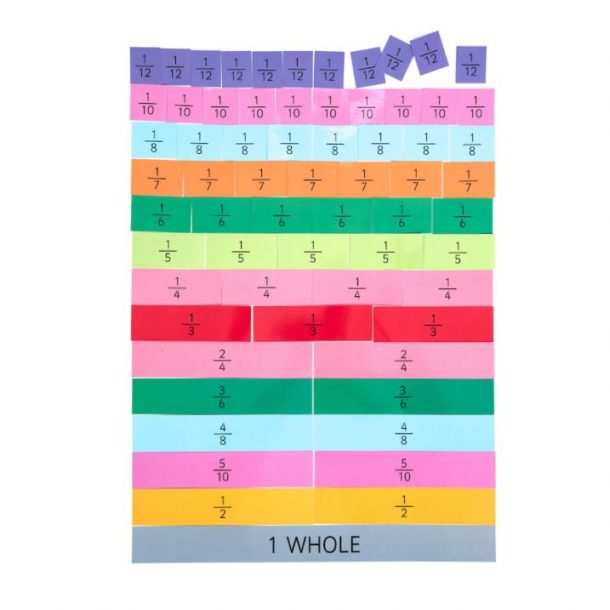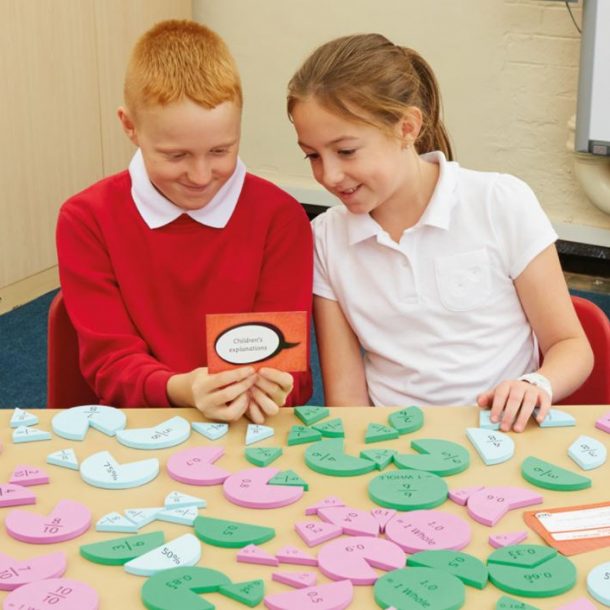There are several problems – firstly, fractions can be so hard to conceptualise. Take ½ and ¼ as examples. Children see the 1 in both and notice they are the same ‘on top’, then they look at the 2 and 4. They have learned over and over that 4 is a bigger number than 2, so it would seem completely logical that ¼ represents the larger fraction!
Secondly, fractions have no fixed amount and they can refer to so many very different things – objects, numbers, time, volumes, money etc.
Thirdly, as the complexity increases, they are impossible to fully understand unless many previous building blocks are firmly in place – understanding of number, the concept of equal-ness, knowledge of times tables and division facts, place value, partitioning, sharing, shape and specific vocabulary – to name but a few.
Having set out what we know to be true about the difficulties, it must also be said that fractions, even though extremely challenging, can also be fun, and overcoming the challenges is very rewarding.
Here we highlight two aspects that are particularly important to give children the best experience and deepen their understanding:
Concrete and pictorial learning (using manipulatives)
Clear and consistent language
These are of course part of mastery approach and included the new DFE maths guidance.
Concrete and pictorial learning
‘Half’ is the first fraction most children will come across and much concrete practise is required before numbers become involved. It is important to be able to understand what half of something looks like and that that ‘something’ is not fixed – half can mean completely different amounts.
Would they like a whole cake?
Or half of this one?
‘Half’ is not just about two parts, but about two equal parts. This understanding of equal-ness is crucial. Talk about sharing fairly.
This early stage is vital to set the understanding of fractions being equal parts of a whole.
As children progress and learn other unit fractions, manipulatives such as the Fraction Wall Class Pack will help. Children can manipulate the pieces and how each fraction fits into the idea of a whole. They will see and compare fractions, understand which are larger and smaller as well as how they can be equivalent. Download our FREE activity sheet with some starter activities that will help.
Fraction Action and Equivalence Action extend learning, demonstrating fractions, both as part of a circle, as well as in blocks and using decimal and percentage equivalents. The value of being able to manipulate and compare, for example ¾, 0.75 and 75% gives some children the insight they would otherwise struggle to see.
Clear and consistent language
Mathematical language should be clear and consistent between year groups; the new DFE maths guidance pulls out the important foci in each area. It is reassuring for children when their teachers are using the same terms and ways of talking about fractions, and by the same token, makes it more difficult if they change them.
The example below shows a clear way to demonstrate the writing of a fraction and the language to go with it. The mastery way is that the fraction bar is written first, then the denominator (what is the whole being split into?) then finally the numerator (how many parts of the whole are there?).
“The whole has been divided…” – write the fraction bar
into four equal parts – write 4 as the denominator
1 of these parts is shaded.” – write 1 as the numerator
Teachers need to be clear about this and children should be able to speak and write their fractions using the same terms. It is important to have lots of practice saying and writing unit fractions before moving on to more complex examples.
The vocabulary needed can be complex, but definitely worth learning from the start; for example, get children used to ‘numerator’ and ‘denominator’, rather than ‘top number’ and ‘bottom number’. They also need lots of opportunities to say the words out loud.
Try this little poem to aid memory.
How I Hate a Numerator!
How I hate a numerator
Such a tricky word,
But the u shows that it’s up on top
Of fractions so I’ve heard!
Denominator’s even worse
That word’s no friend of mine!
But I suppose the D gives me a clue,
It’s down below the line!
Why not have a look at the many wonderful fraction manipulatives and resources available on our website here and while you are there, download the new, free fraction and vocabulary cards!





